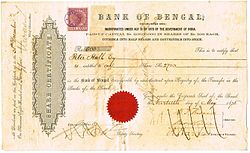Bank of Calcutta
The Bank of Calcutta (a precursor to the present State Bank of India) was founded on 2 June 1806, mainly to fund General Wellesley's wars against Tipu Sultan and the Marathas. It was the first bank of India and was renamed Bank of Bengal on 2 January 1809.
Formerly | Bank of Calcutta |
|---|---|
| Industry | Banking, financial services |
| Fate | Merged with Bank of Bombay and Bank of Madras |
| Successor | Imperial Bank of India |
| Founded | 2 June 1806 |
| Defunct | 27 January 1921 |
| Headquarters | , |
Area served | British India |
HistoryEdit
The bank opened branches at Rangoon (1861), Patna (1862), Mirzapur (1862), and Benares (1862). When it became known that the bank intended to open a branch at Dacca, negotiations began that resulted in Bank of Bengal in 1862 amalgamating Dacca Bank (est. 1846).[1] A branch at Cawnpore followed.
Among the bank's renowned customers were, scholar and politician Dadabhai Naoroji, scientist Jagadish Chandra Bose, India’s first President Rajendra Prasad, Nobel laureate Rabindranath Tagore and educationist Ishwar Chandra Vidyasagar.[2]
The bank was risk averse and would not lend for more than three months, leading to local businessmen, both British and Indian launching private banks which resulted in more bank failures. The most storied bank failure was Union Bank Limited (1829-1848) founded by Dwarakanath Tagore in partnership with British companies.[3]
The Bank of Calcutta, and the two other Presidency banks — the Bank of Bombay and the Bank of Madras — amalgamated on 27 January 1921 and the reorganized banking entity assumed the name Imperial Bank of India.[4] The Reserve Bank of India, which is the central banking organization of India, in the year 1955, acquired a controlling interest in the Imperial Bank of India and the Imperial Bank of India was renamed on 30 April 1955 as the State Bank of India.
See alsoEdit
Citations and referencesEdit
Citations
- ↑ Banker's Magazine, Vol. 22, p.565-6.
- ↑ "A walk down history when India banked on Calcutta". The Times of India. 5 January 2020. Retrieved 26 May 2020.
- ↑ Paul, Aniek (22 August 2015). "The chequered history of Kolkata's banks". Livemint. Retrieved 26 May 2020.
- ↑ "Bank of Calcutta, oldest bank of Asia never failed!". Get Bengal. Retrieved 2 October 2021.
References
- "200 years and going strong". The Tribune. Retrieved 8 September 2006.
Further readingEdit
- Amiya Kumar Bagchi. The Evolution of the State Bank of India. Vol. 1 — The Roots 1806-1876. hindu.com.
